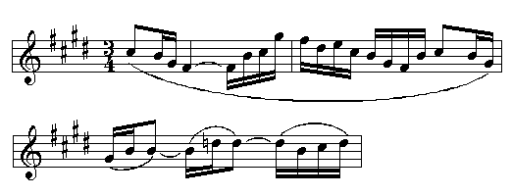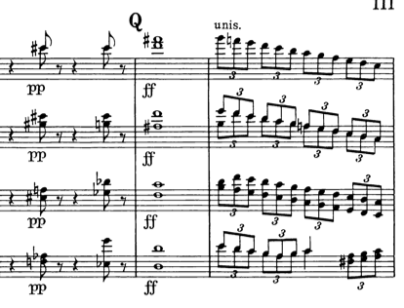“The Vlatava” is a piece of orchestral music composed in 1882 by Bedrich Smetana. It is an ‘orchestral poem’, one of six in his collection of symphonic poems entitled “Ma Vlast” (My Country). The composition follows the Vlatava (or Moldau) river from the beginning of it’s journey as two streams, the hot and cold streams, and continues to follow it’s journey through a royal hunt and a peasant wedding, as well as many other landscapes, castles, and rapids. (W. W. Norton and Co., 2007)
The piece begins with a single flute playing ascending scales at piano (meaning softly), representing the cold stream. Because the flute has a cool timbre, this further supports the assumption that this signifies the cold stream. As the piece is written in a minor key, in this case E minor (judging by the tendency towards the E minor triad in what the flute is playing, and by the key signature), this further adds to the ‘cold’ feeling of the flute’s part. The flute part is written in semiquavers, at allegro (fast) tempo, and this increases the feeling of a fast-flowing stream. The violins and harp both then join the flute, playing either single notes or chords pizzicato (plucked). This creates a sudden, sharp sound, which could suggest obstacles or splashes in the water. Because these parts are played at piano underneath the flute, it supplements the single scales being played by the flute and adds harmony without overpowering the delicate sound of the flute.
At bar sixteen, the flute is joined by a single clarinet. The clarinet is also playing semiquavers, at the same rhythm as the flute, but in contrary motion. With the clarinet’s warmer timbre, this contrary motion could suggest that the clarinet represents the hot stream of the Vlatava.

This contrary motion continues for eight bars, with the musical shape flowing up and down, resembling a river. Adding to this aural representation of a river are the dynamics, going from piano, to crescendo (meaning gradually becoming louder) through a scale on the flute part, then decrescendo (meaning gradually becoming softer) through the clarinet part in the next set of notes. This ebb and flow of sound creates a fluid effect, like water running through a stream.
At bar 24, a single viola joins the mix of instruments. The viola is holding a B, using the bow at a very soft tempo to create a connection between the hot and cold streams. This note is held for four bars before the viola begins playing semiquavers along with the flute and clarinet. The viola plays almost trilled notes, going from B to C, and creating the first consistent melody in the entire piece.

This ties all of the parts together, symbolising the hot and cold streams coming together as one. Eight bars later, in bar 36, the trumpet takes over the soft, held notes – this time playing an E. Both the B played by the viola and the E played by the trumpet are present in the E minor triad, and this gives the piece a definite minor sound and a consistent chord underneath the complex melody being created by the clarinet and flute, which have joined to similar motion in bar 29 to further add to the imagery of the two streams joining together. The contrabass joins the piece at bar 36, taking over the role of ‘obstacles’ in the stream from the violins along with the triangle. The contrabass has a warm timbre, while the triangle has a cool, metallic sound. It can be assumed that Smetana chose to use these instruments to continue the ‘two streams’ feeling throughout the first movement of the piece.
At bar forty, the theme of the piece is played for the first time. It is a stepwise melody played by the violins, staying in the key of E minor. The melody is played dolce, or sweetly, at a piano dynamic. Some notes are played sforzando, with a sudden and strong accent. This adds to the texture of the piece, as before now we have only had fast, trilling semiquavers played very smoothly slurred. “Smetana’s use of dynamic contour also emphasizes that sensation, especially heightened by his use of sforzandos and accents at the top of the melodic line.” (Klein, 2010) Using sforzando notes to add not only dynamics, but also articulation, is a very effective way of giving the listener something unexpected and interesting to hear.
The theme continues to be repeated for the remainder of the movement, with the strings and woodwind picking up the two streams melody. The simple theme on top of the very complex ‘two streams’ creates harmony and chords, adding to the intricacy of the piece. The piece begins to expand after the melody is introduced, with more instruments being added to the composition to add dimension to the sound. The dynamics of the piece continue to follow the same pattern, crescendoing and decrescendoing to symbolise the flowing river.
Eventually, the river begins to flow through a royal hunt in the forest. The theme changes, moving from the flowing melody of the two streams in the violins, to a regal, trumpet melody. The trumpets carry the melody to symbolise royalty or wealth, as trumpet players were rare and treasured in the time when Smetana was writing the piece. The trumpets start the movement with a hunting call, and then move to the theme of the movement. The sound that the theme creates is very stately, reminiscent of court dances of the era. The entire movement stays around the forte (meaning loud) dynamic, with many accents to add to the regal and confident nature of the piece. The violins are still playing the two streams rhythms, but now louder so as not to be lost underneath the blaring brass instruments.
More percussion is added to this movement of the composition, with the timpani providing a tuned percussion to complement the complexity of the movement. The timpani plays a deep roll, which sounds like the pounding of many horses hooves on the ground while they run at a gallop.

The viola and cello are playing underneath the two main melodies – the two streams continued by the violins, and the hunting calls by the trumpets. Because of the simplicity of the trumpet melody, it is necessary to add depth and texture to the piece with deeper notes. This adds harmony to the piece, putting chords underneath what would otherwise be an overly simplistic movement.
The piece continues to move through the countryside, to a peasant wedding at bar 118. The melody changes very dramatically, with the two streams melody thinning near the end of the royal hunt and disappearing completely at the beginning of the wedding scene. The clarinet, bassoon, and violins have the main melody – a flowing theme of quavers and semiquavers.

These instruments may have been chosen as they were the most accessible to peasantry at the time that the piece was written. Violins would have been the cheapest instrument to make, being made of only wood, string (probably made of intestine of some kind) and horsehair for the bow. By comparison the trumpets, which were one of the most expensive instruments to make and one of the hardest to learn to play, do not appear until very late in the movement. Even then, they are played sparingly, and only as chordal notes being held underneath the main melody – still carried by the violins.

While the trumpets are not often used, Smetana takes full advantage of the string and woodwind section, which were not used as much in the royal hunt scene. The sound becomes a rich mix of warm timbres, from violins, bassoons, and clarinets. Harmony is used very obviously in this movement, with similar motion being played a few steps up or down depending on the instrument. For example, in bar 162 there are two violins playing the same melody, however the second violin is starting on a B while the first violin begins on a D. This is a third interval, a commonly used harmonic device.
The articulation in this movement is demonstrably more complex than in other movements. This is because the piece is much more simple, with not as much depth as the royal hunt or two streams scenes. Because of the lower dynamics, mezzo forte (moderately loud) as opposed to forte or fortissimo (very loud) used in the other scenes, as well as the sheer number of instruments being played being lessened, the articulation must be well exhibited. There are many contrasting articulations at the beginning of the movement, with staccato notes leading to nearly two bars of slurs, then back to staccato. This pattern is used throughout the movement.
For the first part of the movement, the melodies and harmonies being played are very similar. The melodies are played with rhythmic mirroring, tying the entire orchestra together. About half way into the section, however, more parts are added with different rhythms and harmonies. For example, in bar 161 the viola is playing a complex melody with fast rhythms. In contrast to this, the cello is playing a very simple harmony to complement the intricacy of the viola’s part.

This pattern continues until bar 172, where the violin and viola melodies die out completely, and eventually the only instruments left playing are the contrabass and the cello, playing very simply one quaver note, repeated for 8 bars until the movement ends.
“The Vlatava”, composed by Bedrich Smetana is a beautiful piece of orchestral poetry. He paints vivid scenes with his music, using many different elements to give the piece depth. He uses articulation and dynamics to his advantage, which along with the complementary rhythms, harmonies, and textures create a complex piece that stays with the listener long after the last note has been silenced.
Bibliography
Cummings, R. (n.d.). Vltava (The Moldau), symphonic poem (Má Vlast No. 2). From All Music: http://www.allmusic.com/composition/vltava-the-moldau-symphonic-poem-m%C3%A1-vlast-no-2-jb-1112-2-mc0002450313
Klein, J. (2010, 2 20). Vltava, Bedrich Smetana – A Listening Guide. Retrieved 5 23, 2013 from http://jfkmusichistory.blogspot.com.au/2010/02/vltava-bedrich-smetana-listening-guide.html
McGraw-Hill Companies, Inc. (1998). The Moldau (1874). Retrieved 5 23, 2013 from http://www.mhhe.com/socscience/music/kamien/student/olc/61.htm
W. W. Norton and Co. (2007). Listening Guide: Smetana – The Moldau. Retrieved 5 23, 2013 from http://www.wwnorton.com/college/music/listeninglab/shared/listening_guides/smetana_the_moldau.pdf















